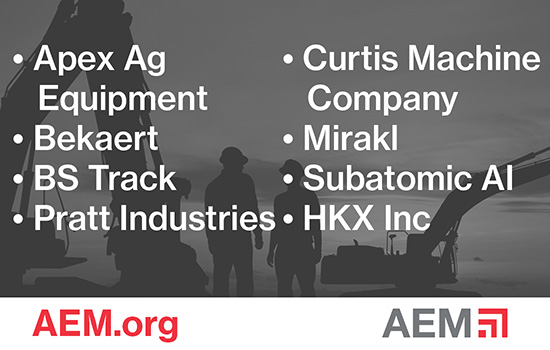Construction equipment has undergone a technological transformation over the past decade, resulting in significant improvements in productivity, efficiency, safety and environmental impact.
AEM’s newly published whitepaper, Benefits of Construction Equipment Technologies and their Impact on Society, discusses four key equipment advancements:
- Machine & Grade Control
- Engines & Drivetrains
- Digital Control Systems
- Machine Telematics
Over the past 30-plus years, those four advancements (among many others) have led to:
- 79% reduction in worksite injuries
- 83% reduction in worksite fatalities associated with equipment
- 96% reduction in NOx and particulate emissions per gallon of diesel fuel consumed
- 13% reduction in CO2 emissions per machine hour
The technological transformation has also brought about game-changing improvements in equipment performance, allowing construction companies to complete projects faster and more accurately. That produces a win-win-win for construction companies, the environment and society as a whole.
Knowledge is Power
Everything starts with machine telematics, which is a set of technologies used to remotely track, monitor and optimize machinery assets.
Like any technology, telematics has continued to evolve over the past decade. Enabled by other technologies such as GPS tracking and satellite positioning, high-bandwidth internet connectivity, smart sensors, advanced imagery, advanced computation, networking and cloud computing, the potential of telematics has grown exponentially in recent years.
“Things have evolved from knowing where a piece of equipment is, to knowing what that piece of equipment is doing,” said Mike Granruth, director of business development at AEM member company Trimble. “That type of information empowers not only those in charge of managing equipment, but also those who manage jobsites and the business as a whole. It all ties to the concept of executing a project that is on time and on budget, and that it’s all done safely.”
Telematics can also help automate some tasks an equipment manager has to perform. A practice known as geofencing is a good example.
“Geofencing allows managers to set alarms and generate alerts when a machine reaches a certain area,” said Ted Polzer, director of product and customer support for North America at AEM member company Case Construction. “Managers can even set up geofences around areas they don’t want a machine to be able to access.”
Given that functionality, geofencing can help enhance not only safety and security, but also environmental impact.
“Say there is a low marshland near a construction site,” Polzer said. “The project manager wants to remind the crew that they shouldn’t go anywhere near that. Setting up alarms and alerts based on geofencing around a sensitive area helps managers take any necessary corrective action with operators.”
As telematics continues to mature, it continues to improve and gain additional functionality. Telematics is beginning to encompass additional data-gathering sensors, such as how much fuel or diesel exhaust fluid (DEF) is in a machine.
Think about a piece of equipment that is left at a jobsite overnight. The crew shows up the next morning, only to discover that the equipment is low on DEF. “With telematics, those types of needs could be picked up prior to starting the day,” Polzer said. “Having that kind of visibility into equipment is a huge time-saver.”
When construction companies save time, they also save money—and that can have an indirect impact on society.
“We like to talk about ‘cheaper, faster, better, greener,’” Granruth said. “The construction company wins, and so does the consumer. Labor and other project costs are reduced. Roads aren’t closed as long. Taxpayer dollars are saved on public projects. And, of course, carbon footprint is reduced as a result of being more efficient.”
Telematics Drives Fuel Savings
To further reduce carbon footprint, telematics is also helping construction companies slash fuel consumption. When telematics is leveraged across all equipment in a construction fleet, millions of gallons of diesel fuel can be saved each year in North America.
“Without telematics, managers don’t have the machine visibility they need to put procedures in place and change operator behavior,” Granruth said. He’s referencing bad habits like allowing a machine to excessively idle, which is hard on an engine and aftertreatment system. Idling also wastes a lot of fuel. In fact, it is estimated that 10-30% of the fuel consumed by construction equipment is nonproductive idling. By leveraging telematics, nonproductive idling could be reduced by 10-15%, on average.
Granruth has worked with a large fleet that did even better than that. The fleet typically consumed 30,000 gallons of diesel fuel per week. By better managing idle time, the fleet has been saving around 6,000 gallons of fuel per week (20%). Assuming a price of $4.18 per gallon, that equates to over $25,000 saved per week. Assuming 50% utilization, that equates to $650,000 in savings per year.
The reduction in carbon emissions has been just as impressive. “This fleet is saving 134,630 pounds of CO2 per week,” Granruth said. “That’s approximately 55 round trip flights from New York to Los Angeles each week.”
Across the entire North American construction industry, the fuel saved from reducing nonproductive idling is equivalent to flying around the world 800 times. The data makes it clear. Leveraging telematics to reduce nonproductive idling is a huge opportunity from both a financial and environmental standpoint.
Construction companies are reducing fuel consumption and carbon emissions in other ways, too. Polzer pointed to equipment utilization and jobsite efficiency.
“Once you back out all of the time a machine spends idling, a good equipment manager can start to get a handle on whether or not certain equipment is even necessary,” Polzer said. Perhaps a site could have functioned just fine with one less loader. On the other hand, maybe the excavators weren’t keeping up with the haul trucks. The equipment manager might want to add more excavators, or perhaps upgrade to larger machines.
“What you don’t want are haul trucks sitting there idling and being nonproductive,” Polzer said. “Telematics can help bring those types of things to an equipment manager’s attention.”
“You can never eliminate downtime because maintenance still needs to happen. But telematics helps an equipment manager pick a good time to schedule it when the downtime will be least impactful.” -- Case Construction's Ted Polzer
Better Maintenance, Less Inefficiency
When equipment managers have better visibility into how their machines are operating, they can also improve the maintenance of those machines. This, too, can produce a win-win-win result.
“Historically, preventive maintenance on equipment has been driven by engine hours,” Granruth said. “Being able to monitor that remotely allows equipment managers to be much more timely with their maintenance.”
“You can never eliminate downtime because maintenance still needs to happen,” Polzer added. “But telematics helps an equipment manager pick a good time to schedule it when the downtime will be least impactful.”
Telematics also has fault code functionality. Various sensors monitor if the engine and other machine components are working correctly. Telematics allows this monitoring to be done remotely, helping equipment managers avert unplanned downtime by scheduling service when disturbing fault codes emerge. All of this helps keep equipment running in peak condition, which helps keeps projects on track.
Now a concept known as “predictive maintenance” represents the next frontier of machine telematics.
“Preventive is simply about scheduling routine maintenance,” Granruth said. “Predictive is about actively monitoring how the machine is performing to determine which maintenance needs to be done, and when.”
For example, an excavator may be tasked to dig in sand, clay or rock. Each environment puts a different level of strain on the excavator. Telematics captures several insights such as fuel burn and hydraulic pressure. “That allows an equipment manager to optimize the maintenance schedule based on what the machine has actually been doing,” Granruth said.
Telematics can also help determine when certain components should be replaced prior to failure. For example, telematics data may show that hoses on an excavator tend to break after a third spike in hydraulic pressure. By taking a predictive approach to maintenance and monitoring the telematics data, an equipment manager can decide to replace that hose after the second spike, before a failure is likely to occur. Perhaps that hose replacement could even take place during the machine’s normal scheduled maintenance to further reduce downtime.
Growing Adoption of Telematics
As the benefits of machine telematics have become clear, more equipment owners are seeking to better leverage this powerful technology. But more needs to happen to ensure widespread adoption. As outlined in AEM’s report, four key actions can play a pivotal role:
- State and federal funding to create efficiencies and long-term ROI
- Incentives to drive adoption
- Education of key stakeholders to understand value
- Securing of needed infrastructure for the technology to work
Granruth said telematics availability and consistency are also key, and have already taken big steps forward. All major equipment manufacturers are offering some level of connectivity and telematics on new equipment now. Granruth said high standards for telematics data and functionality have also been put in place, helping ensure a positive experience for equipment owners.
Polzer said it’s also important to make it easier for equipment managers and technicians to access and use the telematics data.
Case Construction Equipment, for example, integrates telematics data with its electronic service manuals where technicians already spend a lot of time. “Once we grouped all of that telematics data right there with the challenge they were trying to repair, our dealer technicians started using it,” Polzer said. “And once they started using it, they started asking for more.”
On the road forward, it’s helpful to speak to equipment owners about telematics in a way that resonates with them. “Equipment owners must realize that they don’t have to sacrifice productivity and profitability for the sake of sustainability,” Granruth said.
As a matter of fact, telematics can produce a win-win-win for the construction industry, society and the environment.
Want to Learn More?
The Association of Equipment Manufacturers (AEM) released a study outlining how construction equipment technologies have advanced the construction industry and benefited a wide range of stakeholders, from contractors, to owners, to society as a whole.
The Benefits of Construction Equipment Technologies and Their Impact on Society details four construction equipment technologies that play critical roles in advancing the industry, and thereby enabling benefits to productivity and performance, planet and environment, as well as people and safety. For more information, visit aem.org/insights.
Watch for future articles that will discuss three additional construction equipment advances: Machine & Grade Control, Engines & Drivetrains and Digital Control Systems.
Subscribe to the AEM Industry Advisor for more perspectives from AEM members.





